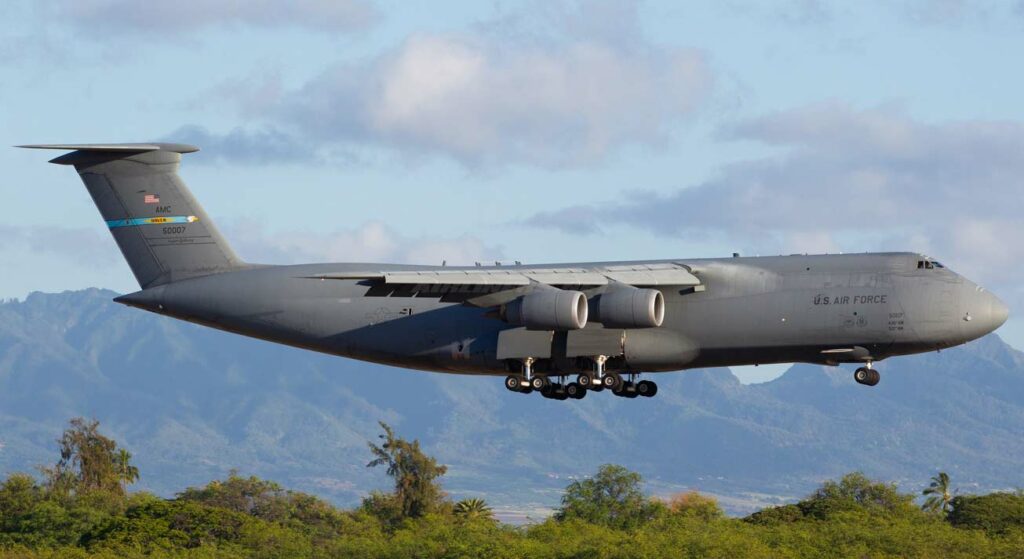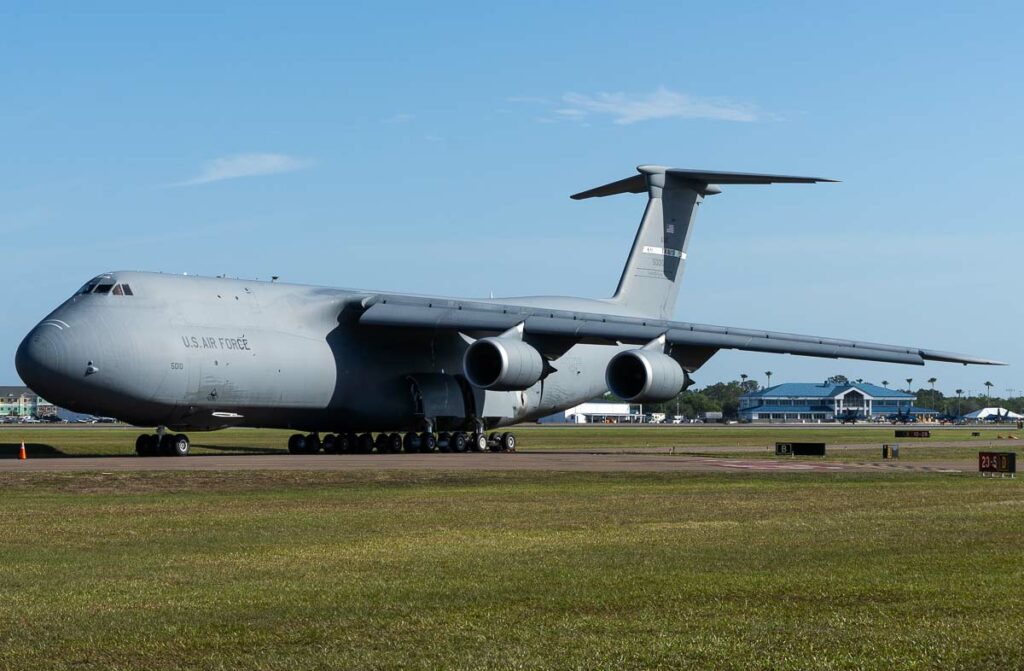The Lockheed C-5 Galaxy is a a strategic military transport aircraft with unparalleled cargo capacity, designed for global logistics support.
In brief
The Lockheed C-5 Galaxy stands as one of the largest military transport aircraft ever built. It boasts a distinctive high-wing design with four TF39 turbofan engines, enabling it to carry oversized cargo across intercontinental distances without refueling. Its loading capabilities are facilitated by a unique visor nose and a rear cargo door, allowing drive-through loading and unloading of vehicles. The C-5’s ability to operate from relatively short runways for its size enhances its strategic airlift capabilities, making it a critical asset for rapid global mobility and logistical support in military operations.

Development
The development of the Lockheed C-5 Galaxy was a monumental undertaking, rooted in the geopolitical and military needs of the Cold War era. The late 1960s were a time of intense rivalry between the superpowers, necessitating advancements in military technology and capabilities. The United States Air Force (USAF) recognized the need for a strategic airlifter that could transport heavy and outsized military equipment, including tanks and helicopters, directly into a warzone across the globe. This requirement led to the initiation of the CX-HLS (Cargo Experimental-Heavy Logistics System) program.
Lockheed’s proposal was selected, and the C-5 Galaxy program was officially launched. The aircraft first took to the skies on June 30, 1968, marking the beginning of a new era in military logistics. The C-5 Galaxy was designed to fulfill the USAF’s strategic airlift requirements, emphasizing range, payload, and the ability to operate from austere runways.
Design of the Lockheed C-5 Galaxy
The C-5 Galaxy’s design is characterized by its massive dimensions. Measuring over 247 feet (75 meters) in length with a wingspan of 222 feet (67.6 meters), and a height of 65 feet (19.8 meters), the C-5 is one of the world’s largest aircraft. Its high-wing configuration and T-tail allow for a spacious cargo hold, capable of accommodating up to 270,000 pounds (122,470 kg) of cargo. The aircraft’s design features a distinctive nose visor and rear-loading ramp, facilitating efficient loading and unloading operations.
Powered by four General Electric TF39-GE-1C turbofan engines, each producing 43,000 pounds of thrust, the C-5 Galaxy can achieve a maximum speed of 570 mph (917 km/h) and a range of approximately 2,800 miles (4,500 kilometers) with a full payload. Its operational ceiling is 35,700 feet (10,880 meters).
One of the most significant design challenges was ensuring the aircraft’s structural integrity while maximizing cargo capacity. The use of high-strength materials and advanced engineering techniques allowed Lockheed to overcome these challenges, resulting in an aircraft capable of carrying more cargo over longer distances than any other military airlifter at the time.
Performance of the Lockheed C-5 Galaxy:
In terms of performance, the C-5 Galaxy has set the standard for strategic military airlift. Its four TF39 engines provide the power needed to carry payloads weighing up to 270,000 pounds (122,470 kg) over distances of up to 2,800 miles (4,500 kilometers) without refueling. This capability enables the USAF to project power globally, delivering troops, vehicles, and equipment directly to forward operating bases and conflict zones.
When compared to its contemporaries, such as the Russian Antonov An-124 Ruslan, the C-5 Galaxy offers a larger payload capacity but at the expense of shorter range and higher operational costs. However, its ability to operate from less prepared runways and its unique cargo handling features have solidified its role as a critical asset in the USAF’s logistics and mobility strategy.
Variants of the Lockheed C-5 Galaxy:
The C-5 Galaxy has seen several variants over its operational life, including the C-5A, C-5B, C-5C, and the modernized C-5M Super Galaxy. The C-5A was the original version, while the C-5B introduced various improvements, including enhanced wings and updated avionics. The C-5C was a specialized variant modified to carry large and bulky items, such as satellites. The C-5M Super Galaxy is the latest version, featuring modernized avionics, upgraded engines (General Electric CF6-80C2), and improved reliability and performance.
Military Use and Combat of the Lockheed C-5 Galaxy:
The C-5 Galaxy has been a workhorse for the USAF, supporting military operations and humanitarian missions around the globe. It has played a crucial role in conflicts such as the Vietnam War, the Gulf War, and operations in Afghanistan and Iraq. The C-5’s ability to transport vast quantities of supplies, vehicles, and personnel directly to conflict zones has proven invaluable in rapid response and sustainment operations.
Despite not being armed, the strategic value of the C-5 Galaxy lies in its logistical capabilities. It has enabled the USAF to establish and sustain forward operating bases, support allied forces, and conduct humanitarian aid missions in disaster-stricken regions. The aircraft’s versatility and capacity have often given the U.S. and its allies a strategic advantage in various conflicts.
While the C-5 Galaxy has faced competition from other heavy-lift aircraft, such as the Antonov An-124 and the Boeing C-17 Globemaster III, its unique capabilities have ensured its continued use. The C-5M Super Galaxy, with its modernized systems and improved performance, is expected to serve well into the future, maintaining the legacy of the C-5 as a vital component of global military logistics.

The Lockheed C-5 Galaxy represents a pinnacle in strategic airlift capability, combining vast payload capacity with global reach. Despite the challenges inherent in operating such a large and complex aircraft, the C-5 has proven itself as an indispensable asset for the United States Air Force. Through its various variants and continuous upgrades, the C-5 Galaxy continues to enable rapid, flexible, and strategic projection of military power and humanitarian assistance across the globe.
Back to Transport planes.